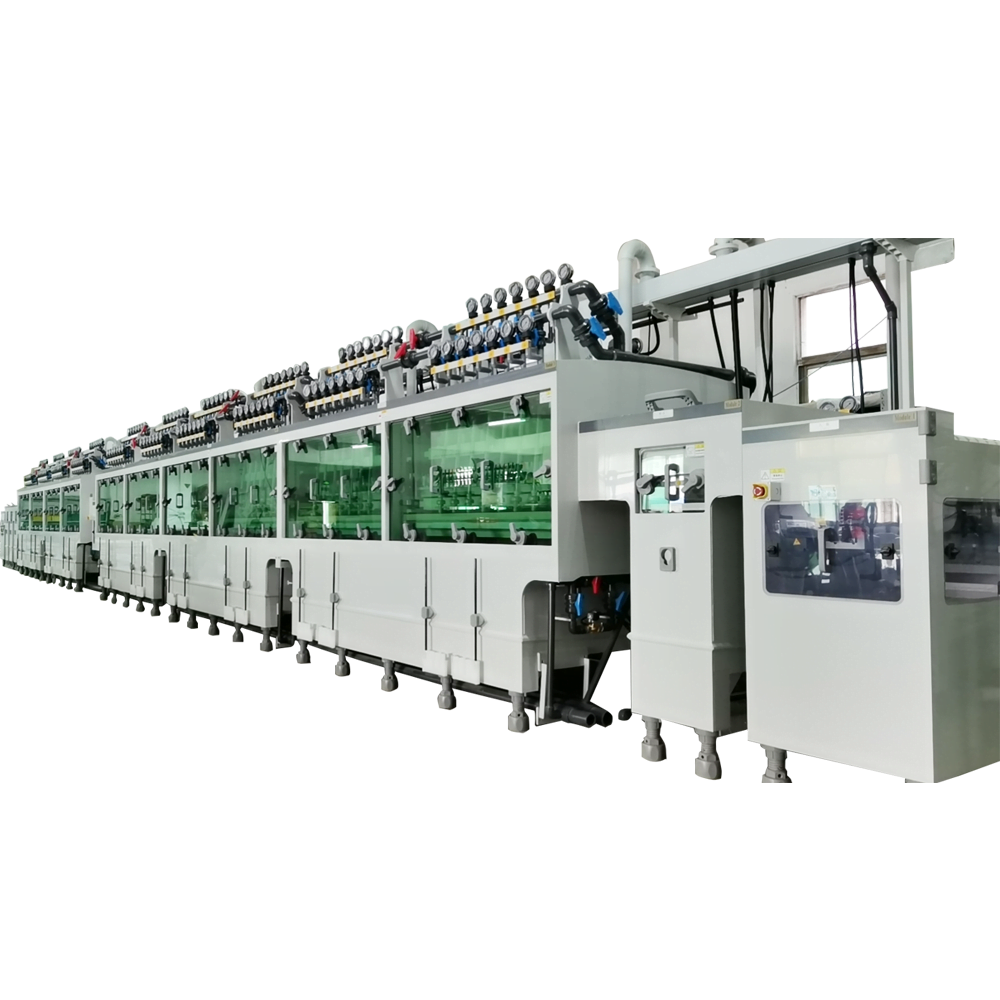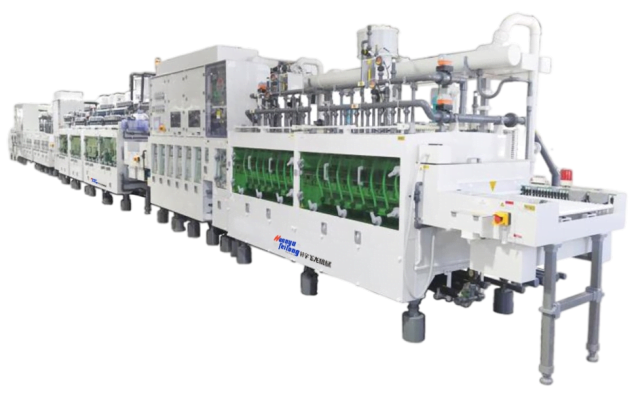Wet Processing Equipment for All Chemical Acid Etching Purposes

Selling Price:
$4000.00/m
Wet Processing Equipment – wet chemical acid etching machine
The Chemical acid etching machine is used to spray chemical solution to a copper-clad laminator, aluminum substrate, or stainless steel plate, the exposed copper, aluminum, and stainless steel are etched away, retaining the pattern or circuit covered by the corrosion-proof film, so as to achieve the purpose of making pattern or circuit.
Customized chemical acid etching machine will be reasonably matched with your production line according to your production capacity.
Precision: The etching precision of our machine is 0.0028mm, which allows us to manufacture micro-sized components with high accuracy.
Speed: The etching speed of our machine is determined by the qualityand temperatureof the etching solution used. Typically, higher temperaturesresult in faster etching.
Yield: Our machine achieves a high yield rate of 99.9% due to its high precision and controllable etching speed, which greatly improves manufacturing efficiency and reduces costs.
Manpower: Only two employees are needed to operate and maintain each machine, which reduces labor costs and increases production efficiency.
Chemical Acid Etching Machine Equipment Parameters
| birthplace | China |
| Guangdong | |
| brand | Dragon Etching |
| core inter-layers | 2 mil(where 1 mil is equal to 0.001 inches.) |
| PCB construction where | 250 mil |
| working width | 500/600/700/800MM customized |
| high | 900-1100mm customized |
| Thin Material Transport for PCB | 1m-100m depends on output |
| Voltage | 380V/415V/440V customized |
| Material | Polypropylene 12/15/ 20MM |
| Specificities | Flexible reel-to-reel Kapton,Rigid FR4,1~100m,2 mil material can be transported no problem(OEM) |
| heating type | SST316 titanium heater |
| Modular metal | SST316 titanium material |
| apply to | high precision etching (Wet Processing for PCB) |
| Common Processes | Etcher (Stand Alone)DES (Develop – Etch – Strip)SES (Strip – Etch – Strip)Custom Size (1 to as many chambers as you want) |
| Common Chemicals Etchant | Alkaline Etchant Cupric Chloride Etchant Ferric chloride Etchant Hydrofluoric Acid (HF)Micro etch |
| After Warranty Service | Video technical support, online support, spare parts |
Wet Knife mold etching machine
WET Knife mold etching machine for etching knives. Have the ability to professionally customize knives.
This etching machine is an all-in-one small knife and mold etching machine. It is easy to install and can be used after powering on.

Selling Price:
$12,000.00
Popular Wet Processing Combination Equipment
(DES) Develop – Etching – Stripping
DES noun explanation
(D) Developing
In photofabrication, developing is the post-exposure process.
Dissolve and remove the photoresist other than those required and form a pattern image of the photoresist.
There is a “soaking method” of immersion in the developer and a “spray method” of spraying, and there is a common use of spray methods in terms of supply efficiency of the developer.
Immediately after the development, a set of heating treatments called post-baking are carried out.
The post-baking box hardens the photoresist, which results in resistance to etching fluid in the next process and improves adherence to substrates.
(E) Etching
Etching is a post-developing process.
While continuously transporting using etchants suitable for metal materials (products), a large amount of etching is performed uniformly by the spray method.
As the management of the etchant is important, an etchant autoanalyzer is installed as a supplementary facility, and various chemicals are automatically supplied based on the feedback of each component analysis to maintain a constant etching rate.
(S) Stripping
Stripping is the post-etching process.
After etching, dissolve the unnecessary photoresist film.
Depending on the type of photo registry, sodium hydroxide heated around 40 to 80℃ or 100℃ is commonly used.
In the case of special resist, mixed solvents such as xylene, alcohols, and ketones may be used.
If the product cannot be stripped by immersion, physical force such as a brush or spray is applied to the product. Immediately after stripping, De-ionized water cleaning, drying, and rust prevention are performed as a set.
DES Line’s Advantages
By installing 3 processes on one device…
- the unit’s area becomes smaller.
- Since there is only one inlet (LD) and outlet (ULD), it can be operated by a minimum number of people.
- It’s cheaper than purchasing three separate machine
DES Line’s disadvantages
By installing 3 processes on one device…
- The tact time of the device is rate-determining in the slowest process.
- When a product defect occurs, it is difficult to determine which process is the cause.
- It is not suitable for various kinds of products whose processing conditions change significantly.
- It is not suitable for research and development purposes that assess and select types of photoresist or film thickness.
(SES) Strip – Etch – Strip Line (outer layers)
The Dragon Etching SES lines with innovative filter systems clean the entire stripping solution before it is returned to the tank container. Depending on the resist type, a cyclone filter system, a drum filter system, or a combination of both is used. The stripping process adjusts to the type of resist and then removes the remaining photoresist on the circuits.

Metals that can be processed by wet acid etching machine
- Wet Etching Invar
- Wet Etching Germanium
- Wet Etching Gallium Nitride (GaN)
- Wet Etching Indium
- Wet Etching Cobalt
- Wet Etching Tungsten
- Wet Etching Stainless Steel
- Wet Etching Aluminum
- Wet Etching Kovar
- Wet Etching Copper
- Wet Etching Steel
- Wet Etching Nickel
- Wet Etching Platinum
- Wet Etching Silver
- Wet Etching Rhodium
- Wet Etching Hafnium
- Wet Etching Vanadium
- Wet Etching Zirconium
- Wet Etching Titanium
- Wet Etching Niobium
- Wet Etching Tantalum
- Wet Etching Molybdenum
- Wet Etching Brass
- Wet Etching Rhenium
Wet Processing Equipment
Wet Chemical Etching Machine
Customize your Equipment
- Check out our Wet Processing Equipment.
- Select the product you are interested in, to find all your possible options.
- Then contact your sales rep to get moving on your new piece of equipment.
- If no products catch your eye please contact us. We have done many 100% customized machines!
Our metal etching equipment processing workshop
Features that can be added to a wet etching machine:
- Acid Controller – Popular for cupric chloride etchant
- Drying – Ensures products come out of the line dry.
- Inline Filtration – Results in fewer clogged nozzles and particles in solution.
- Ion Exchange – Saves water in rinse stations.
- pH Controller – Popular option for Alkaline etching. Standard on developing and resisting stripping lines.
- Ventilation Demister – Aids in condensation and recovery of evaporated process chemistry.
- Thin Material Transport – Transport very thin and flexible materials without the use of leaders.
- Drip Pan – Catches chemistry drops or spills
- Chiller Cooling System – Increased cooling capabilities.
- ORP Controller – Popular option for Cupric and Ferric etchers. Comes with a regeneration system.
- Specific Gravity Controller (IX) with Visual Baume – Prevents etchant Baume from getting too low or high.
- Recipe-Driven Operation – Eliminates product variation due to improper machine set-up.
- Data Collection and Archiving – Gives real-time and historical feedback analysis.
Typically used for PCB outer layer etching
The options do not stop there. WET ETCHING wet processing machines are modular — allowing you to configure your machine in any order you desire.

